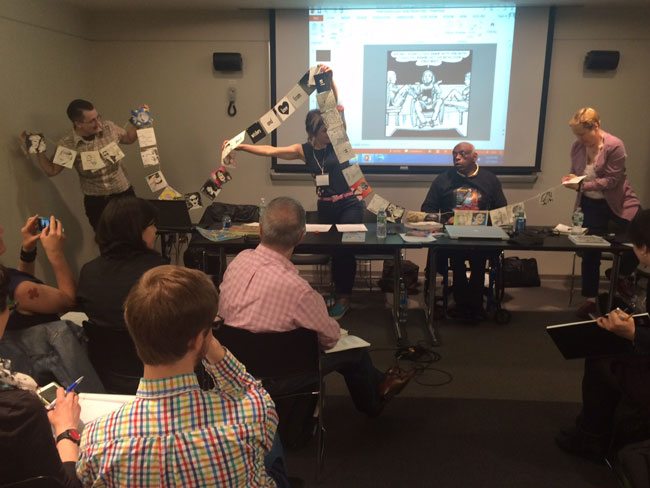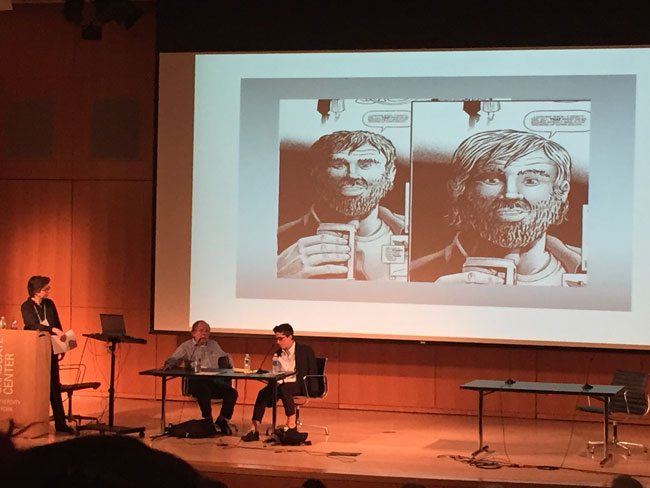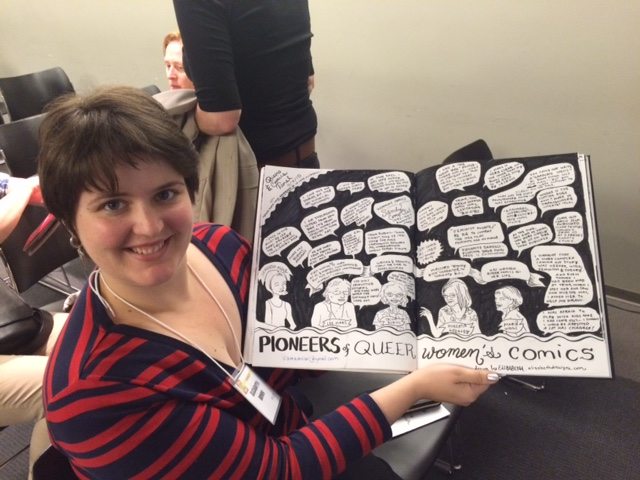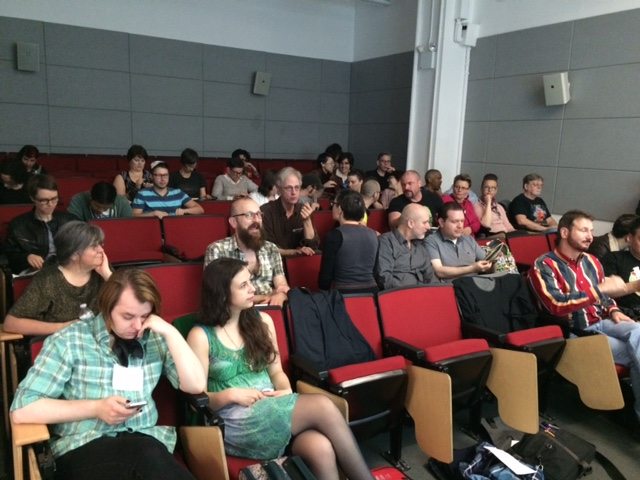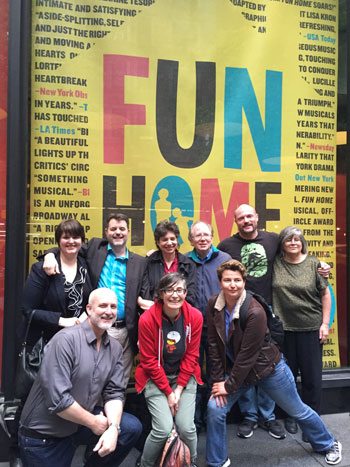Not everyone was there, but the mix that made it was sizeable, intergenerational and international. That made for an historic Queers & Comics Conference, the first ever, held at the Center for Lesbian and Gay Studies (CLAGS) at The Graduate Center of City University of New York (CUNY). I was there for the whole shebang and will do my best to break it all down, blow by blow, panel by panel. Come along with me, won't you?
First, this: Queers & Comics (Q&C) would never have happened without the vision of Jennifer Camper, one of the godmothers of LGBTQ cartooning, and our premier event instigator and organizer. With the able assistance of andré carrington, PhD, the committee chair, Jen brought together a diverse mix of cartoonists, publishers, and scholars "to discuss their craft, and document the history and significance of Queer Comics." The conference was a resounding success, with a particularly strong showing of the pioneering first wave of cartoonists, and two of our greatest creators featured as keynote speakers. And all it climaxed with a bunch of us going to a hit Broadway musical on Saturday night (a gay cliché, but true).
Everything kicked off on Wednesday night with a "Drink and Draw" at The Eagle, a leather bar in NYC's Chelsea neighborhood. The special guest was Gengoroh Tagame, the legendary manga creator. Regrettably, I was unable to attend this event, thrown together by Ivan Velez, Jr. as part of his fabulous ongoing Oso Oro series, but my special correspondent Justin Hall filed this brief report:
The NYC Eagle donated its ground floor to the 7-10 pm event. It drew a big, boisterous, well-lubricated, and diverse crowd, with well over 100 people attending, maybe 20% of them women (extremely unusual for the Eagle). Throughout the night there were models to draw, from Sasha Velour's drag to stripped-down muscle bears of every age and ethnicity. The crowd responded, with many sketchpads (supplied, along with drawing implements) that were filled by the end of the night. Gengoroh Tagame drew with gusto and gave away several of his pieces. It was a huge success, with a dynamic, joyous energy in the air, and friends being made or reconnecting for the first time as the Queers & Comics festivities began. At the end, the Eagle opened up its second floor for its infamous jockstrap night. (There were a few confused patrons of said event who sidled by the remaining queer comics crowd on their way up the stairs, asses in the breeze.)
The conference proper began bright and early Thursday at 9am. Both days featured five sessions, each lasting one hour and forty-five minutes, ending with a keynote address from 7-9pm. I wasn't on any panels that first day, so I was determined to attend each session, as a good reporter should (I channeled Jimmy Olsen but managed to stay out of trouble). It was tough choosing panels, but luckily most of them were taped for later viewing. For the 9am Session 1, I went with "Porn This Way: Male Sexuality in Comics", moderated by our previously mentioned pal, Justin Hall. That meant missing Nicole Georges' "Queer Memoir" panel, "Pedagogical and Theoretical Approaches to Queer Comics", moderated by Yetta Howard, and Blue Deliquanti's "Queers in Other Worlds: Pushing Boundaries, Speculative Fiction, Anti-Realism". (Is that a diverse set of topics or what?) "Porn" featured a lively conversation touching on the myriad approaches to depicting gay male sex in comics. A particularly interesting thread explored using sex to explore and build character vs. its facility to induce "bone-crushing erections" (as panelist Steve MacIsaac memorably phrased it). Mike Diana, Jon Macy, and Carlo Quispe examined the politics of sex, offering their political motivations for drawing what they do. Scholar Darieck Scott and web artist C. Edwards lent insights and support.
For Session 2, I opted for “Queer Comics, Health, and Disability”, moderated by my pal Annie Murphy and featuring Ellen Forney, Rupert Kinnard, and “Comic Nurse” MK Czerwiec. (BTW for further reading on comics and health, see Whit Taylor's piece on the Comics & Medicine Conference last year at Johns Hopkins University here on TCJ.) Ellen Forney spoke about creating her graphic memoir Marbles (2012), which chronicles being diagnosed with bipolar disorder shortly before her thirtieth birthday and examines the links between mental health and creativity. MK Czerwiec, aka "Comic Nurse," a licensed nurse and academic, discussed the power of comics to convey health information, and pointed to a new anthology series she contributed to, Graphic Medicine Manifesto, the first issue of which is due out this month. Rupert Kinnard, creator of the groundbreaking strip Cathartic Comics and his graphic memoir The LifeCapsule, related his experiences as a gay African-American cartoonist who in 1996 became "less-abled" after a car accident left him partially paralyzed. He spoke movingly about community support, unveiling a beautiful string of individually drawn cards of well wishes from fellow cartoonists, organized by Alison Bechdel while he was recovering. I had contributed a drawing but had never seen the finished piece; the string was so long all four panelists had to hold it up. The project clearly meant a great deal to Rupert and his reveal was very moving. This was the first but not last time I would see a few teary eyes at this conference.
After lunch, I went to "Wrangling Words & Pictures with Howard Cruse & Alison Bechdel (Master Class)", moderated by Jen Camper. Against a generous backdrop featuring their work, Howard and Alison shared personal histories and insights into their creative processes. They also discussed all sorts of technical information about scripting, inking, light-boxing, letter, coloring, designing and layouts, photo referencing, art supplies, and other minutiae. Jen loves talking about this stuff but worried aloud that the non-cartoonists in the audience might be bored; my husband John and two non-cartoonist friends in attendance assured me it was fascinating. So fret not, Jen! Inking is a totally riveting subject as far as I'm concerned.
For the day's final session I attended "Pioneers of Queer Women's Comics", moderated by Samantha Meier and featuring Trina Robbins, Mary Wings, Lee Marrs, and Roberta Gregory. Listening to this group, the breadth and depth of the conference really hit me. These women literally created lesbian comics as we know them today. In 1972, Trina Robbins drew the first non-pornographic lesbian comic narrative, "Sandy Comes Out". (Fun Fact: Sandy is Robert Crumb's sister). Artist Mary Wings felt Trina's story too simplistic and in 1973 self-published Come Out Comix, the world's first lesbian comic book. (Mary and Trina were humorously affectionate antagonists throughout the session and I kept thinking they should have their own podcast or something.) Roberta Gregory started her Feminist Funnies strip in a college newspaper in the early '70s and self-published Dynamite Damsels in 1976, which was more of a professionally produced, standard comic book than Come Out Comix. Lee Marrs was one of the "Founding Mommies" of Wimmen's Comix, and creator of the wonderful underground series Pudge, Girl Blimp. Marrs would go on to produce classic stories like "Stick in the Mud" and "My Darling Deadly Dyke" for early issues of Gay Comix.
All four women spoke about the travails of pioneering the depiction of subject matter that society finds uncomfortable. Mary said she worried about being arrested for being a pedophile for some of the work she drew, while Trina recalled being ostracized by the boy's club of the underground comix scene.
Some very cool things were revealed near the end of the panel: Fantagraphics will be reprinting the entire run of Wimmen's Comix in a deluxe volume very soon (!), Trina is writing her memoirs, Mary Wings is getting ready to return to comics after many years of writing lesbian detective novels, and Roberta is gearing up for drawing comics more regularly once she retires from her day job. These women are full of great stories and still going strong, inspiring new generations:
Some of the other diverse panels going on during Sessions 2-4 included: "A Conversation with Gengoroh Tagame", "LGBT Comics for Younger Readers", "Memoir: Discovering Queer Identities", "Creating Trans & Genderqueer characters in Comics", "French LGBT Comics", one about zines & minicomics, and another covering webcomics.
After the dinner break, the legendary Howard Cruse took to the auditorium stage for his keynote address. He spoke eloquently about the personal and professional risks he took coming out as a gay cartoonist, his editorship of Gay Comix, creating his '80s strip Wendel for The Advocate, and the arduous creative process of creating his Eisner- and Harvey Award-winning magnum opus, Stuck Rubber Baby (1995). Always the gentle, soft-spoken revolutionary, Howard paved the way for many of us—and we gave him a standing ovation as we blinked back tears.
I had been looking forward to the customary "Big Dinner Out" with folks afterward, but it seemed like all my buddies were just as wiped out as I was – New York can do that to a body. John and I went out for a quiet late dinner to debrief and headed back to our hotel for much needed sleep.
Friday was my panel day. Scheduled to appear on three of them myself, I regrettably had to miss such discussions as "Pioneers of Queer Men's Comics", "Creating Queer Characters of Color", and "A Trans/Gender Queer Roadtrip". My first panel was "Publishing and Self-Publishing Queer Comics", moderated by Northwest Press publisher Zan Christensen, and featuring Jane's World creator Paige Braddock, along with the original publisher of Gay Comix and founder of Kitchen Sink Press, Denis Kitchen. This was a great way to start my day: Zan and Paige were delightfully loose and wryly funny throughout, while Denis revealed himself as a true mensch (Fun Fact: he gifted a copy of Howard Cruse's deluxe paperback collection The Complete Wendel to every single Q&C panelist). We covered lots of ground: starting out, dealing with printers, finding distribution, getting reviewed, using social media (my advice: if you're going to use it, USE IT), and beyond. I hope our conversation gave the audience some useful tips and information. Though all four of us panelists have very different backgrounds, a common thread seemed to be that we all sort of stumbled into publishing…and just kept going. DIY, baby.
Next up was "To Be Continued: Creating a Serialized Queer Comic Strip", moderated by my buddy Eric Orner, creator of the classic '90s-era strip The Mostly Unfabulous Social Life of Ethan Green. Fellow panelists included that Dyke to Watch Out For, Alison Bechdel; the co-creator of Chelsea Boys (and recent Emmy nominee!) Allan Neuwirth; breakout star and Wuvable Oaf creator Ed Luce; and Paige Braddock. We discussed the many facets of creating serialized work, including drawing characters repeatedly (something many of us faced with trepidation), creating a sense of place, writing from character, censorship issues and more, including ultimately, quitting. Appearing on this panel with these tremendously gifted artists was a treat. I could have happily sat there for another hour, listening and gabbing.
After the lunch break it was time for the Gay Comix reunion/plenary. Ably moderated by Hilary Chute, it featured original publisher Denis Kitchen, along with all three editors (quite a coup) from the series' eighteen-year run: Howard Cruse, who helped launch it in 1980, editing the first four issues; Robert Triptow, who kept things running from issues five through thirteen in the mid '80s to early '90s; and Andy Mangels, who changed the name to Gay Comics before re-launching it in 1992, helming it from issues fourteen through twenty-five. Each had his own vision for the series. Howard was very much influenced by the Wimmen's Comix creators, wanting to go beyond sex jokes, camp, and erotica to tell personal stories exploring real lives, while Triptow felt it was important to emphasize comedy along with political anger and coming out stories (this was during some of the darkest days of the AIDS crisis): "No one's ever won an argument in the history of the human race," he told potential contributors, "so let's seduce them with humor." For his part, Andy Mangels wanted to take the comic more into the mainstream to increase visibility, and made it a point to make the content of each issue 50% by men and 50% by women. With slides of each issue's cover art, each editor reminisced about his experience working on the series, both pros and cons. Later, contributors from the run of the series were invited to the stage to share a few words. I had actually been in a few of the late issues, thanks to Andy Mangels, but as a minor contributor, I stayed seated to enjoy listening to what the people who were truly the books' lifeblood had to say. Gay Comix was the first underground comic I ever saw. I'm grateful it existed and glad this panel happened.
For the final session of the day I was on "Queer Male Identity and Comics", moderated by my friend Sina Shamsavari, Ph.D., and featuring Dylan Edwards, Michael Fahy, and Jon Macy. These guys are all friends with whom I've worked on the Boy Trouble and/or QU33R anthologies, so it felt like a bit of a reunion. The core of our discussion was our places in the second wave of queer cartoonists (with Dylan, in my opinion, actually in the early rise of the third wave), and whether we were drawing in reaction to our forebears or simply trying to expand the conversation they started (I feel probably a little bit of both). I got to thinking about artistic generations and how important it is that they study one another, learn from each other, and communicate as well. That's what keeps the continuum moving forward, not ossifying. That was my take from this session, and the conference as a whole.
Among the other panels and workshops that were happening during my marathon: "Bookmaking and Handmade Comics", "Touring and Promoting Your Work", "Telling the Truth is a Revolutionary Act: Queer Non-fiction Comics", and (can't leave this one out!) "Wet and Sticky: Female Sexuality in Queer Comics."
At 7pm was Alison Bechdel's keynote, which drew the events at CLAGS to a proper close. The full-capacity crowd listened raptly to Alison reminisce about being a lesbian cartoonist, beginning with the years of creating Dykes to Watch Out For and on to her brilliant graphic novel Fun Home, which catapulted her to international acclaim. She shared slides from some of her funniest stories over the years, including her hilarious takedown of the Michigan Women's Music Festival, "My Own Private Michigan Hell", and her account of enjoying cult minority cartoonist status vs. yearning to break free of categorizations in "Oppressed Minority Cartoonist", which encapsulates so much of what we all deal with professionally and personally. Naturally, she spoke of the bizarre and wonderful circumstances that led to Fun Home's transformation into a hit Broadway musical (12 Tony nominations!), and in a way, we all shared in enjoying her hard-earned kudos. Humble, thankful and still a bit shell-shocked by her journey, she was visibly moved to be among her peers and to reflect on our shared history. She received a warm, sustained standing ovation.
Once again, at the end of the night I was fried and regrettably not up for a big social evening out, so my buddy Craig Bostick joined John and me for another light dinner and drinks at the Metro Grill. Craig, who designed the gorgeous Queer Pin-ups playing cards created to raise money for Q&C, is a mellow guy; he and I hung out for much of the conference.
Saturday afternoon, from 1:30 to 3:30 at the School of the Visual Arts, "Queer Comix Live!" was held, featuring twenty-nine of us still somewhat tired but thoroughly game cartoonists reading our work with slideshow accompaniment. The event was loose and lots of fun, running an hour overtime. Some of my favorite readings included Soizick Jaffre's all-French piece, Sina's rendition of his story from QU33R, Bill Roundy's clever use of music (from his iPhone) to narrate his story, Maureen Burdock's reimagined fables, Jay Fuller's adorable "Boy with the Pink Earmuffs" character, Joana Estrala's excerpt from her book Propaganda, Tyler Cohen's all-too-brief Mama Pants strips, and Dutch artist Jiro Ghianni's quirky, pixie-like presentation. At the end, Robert Triptow made a special point to encourage the newer, younger artists to keep going, pointing to his late-career, first-ever solo book of comics, Class Photo, due out this fall from Fantagraphics.
That night was Fun Home at the Circle in the Square Theater. Superhero Ted Abenheim of Prism Comics worked with the theater in making a large block of tickets available for us cartoonists, and set up a post-performance conversation for us with Alison and most of the cast. Our cartoonist crowd was pretty casually dressed, and when I remarked with a grin to Jeff Krell how nice it was to see someone else wearing a jacket, he responded wryly: "I thought it was appropriate." John and I were seated next to Howard Cruse and his ever-charming husband Ed Sedarbaum. I got a little thrill out of the fact that all three happily talked Broadway musicals prior to curtain. The play itself was really wonderful and I hope it picks up at least some of the twelve Tony Awards for which it has been nominated, especially for Michael Cerveris' haunting portrayal of Bruce Bechdel, and Sydney Lucas' stunningly mature performance as young Alison Bechdel (I'm still singing her "Ring of Keys" number to myself days later). The special after-show audience with Alison and cast members gave us some real insights into the process of adapting and shaping the book for the stage. It was a fabulous, somewhat surreal night, the perfect capper to the conference (there was a cartoonist's lunch Sunday afternoon but we flew out the next morning).
Jen Camper—that rarest of creatures, an extroverted cartoonist—told me that when she was mildly fretting to Ed Sederbaum about not being able to see or do much with anyone for any sustained length of time due to her endless organizing duties, Ed sagely told her: "The actor never gets to see the play."
I know how Jen feels. At these events you're always missing out on something –in my case, many somethings. I never managed to see or meet people like Samuel Delaney, Rachael House, or Gengoroh Tagame, among others (Eric Orner and I are mutually bemoaning the fact that we never got to meet first-waver Gerard Donelan). I only spoke briefly to Ted Abenheim, Tony Breed, Greg Fox, Nicole Georges, Melanie Gilman, Nick Leonard, Sasha Steinberg, and Christopher Wilde. But I was happy to finally meet cartoonists whose work I'd been reading for years, like Leslie Ewing, Rupert Kinnard, and AK Summers, and newer or previously unknown to me creators like Elizabeth Beier (who live-drew many panels, much to everyone's delight), Soizick Jaffre, Jiro Ghianni, and MK Czerwiec. Above all, I finally met Michael Fahy, the great artist (and creator of the Q&C logo) from Philly with whom I've been corresponding and working since 1994—so I'd say this meeting was long past due. I also never got a chance to peruse the scores of various queer comics that Ted Abenheim and Tara Madison Avery were selling over in Room 197, but I heard sales were strong. Several people—among them Zan Christensen, Blue Delaquanti, Ed Luce, and Steve MacIsaac—had to leave early in order to get to TCAF, the Toronto Comic Arts Festival. The fact that they made the extra effort to travel to Q&C speaks to the epochal quality of the conference. A peek at the Q&C Twitter feed featured comments from many cartoonists lamenting their inability to attend.
A running theme throughout, at least from the people I talked to, was the unexpected emotion of the event. Understand: queer cartoonists have dealt with being misunderstood, ignored, censored, and even ostracized for a good deal of our run in the timeline of alternative comics. The anecdotes and oral histories we heard from our forefathers and foremothers in the panels are ample proof of that. The minute we stepped into The Graduate Center at CUNY, the sense of validation and comradery in the halls and panel rooms was real and at times quite intense. Ivan Velez, Jr. summed it all up on his Facebook page: "Jennifer Camper has created an amazing and poignant moment in time. She should be proud of herself and all her helpers. This event rocked us all." When and where a Queers & Comics 2 will take place remains to be seen, but the importance of this first-ever conference cannot be overstated. It will be sending forth ripples for months and years to come. We were Here and Super-Queer for a few wacky and whacked out days in New York City. It really happened, one for the history books.


